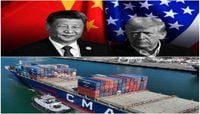In a significant escalation of the ongoing trade war between the United States and China, the Chinese government has announced a halt to the export of several critical rare earth metals and magnets. This move, reported by the New York Times, is poised to have far-reaching implications for several global industries, particularly the automotive, semiconductor, and aerospace sectors.
As of April 14, 2025, China is in the process of implementing a new export regulation system, which will stop the supply of essential magnets and heavy rare earth metals from a number of its ports. These materials are vital for the assembly of various high-tech products, including cars, drones, and military missiles. The New York Times noted that this decision could significantly disrupt production activities for certain companies, particularly American military contractors, as well as impact supply chains to countries like Japan and Germany.
While the cessation of these exports represents a small fraction of China's overall export economy, the ramifications for the U.S. and other nations could be severe. The New York Times emphasized that although rare earth magnets constitute only a minor share of China's total exports, their absence could lead to substantial challenges for industries reliant on these materials.
In the wake of this announcement, stocks related to rare earth materials have surged. By 10:10 a.m. on April 14, shares of Union were trading at 6,440 won, reflecting an increase of 10.84% from the previous day. Union opened at 6,710 won, marking a 15.49% rise, and peaked at a remarkable 15.83% during the trading session. Meanwhile, Union Materials, a producer of ferrite magnets, saw its stock rise to 2,130 won, up 6.23% from the prior day. This surge is attributed to the expectation that domestic companies in South Korea will benefit from China's export suspension.
The New York Times reported that this situation is perceived as a counter-response to the U.S. government's recent announcement of tariffs that could reach up to 145% on all Chinese imports. The trade conflict is intensifying, with both nations engaging in retaliatory measures that could reshape global supply chains.
China's control over rare earth metals is particularly noteworthy, as it dominates the market with approximately 99% of the global supply of heavy rare earth metals and produces around 90% of the magnets made from these materials. This dominance gives China considerable leverage in international trade, particularly in technology sectors that rely heavily on these resources.
Currently, many shipments are reportedly stuck at Chinese ports due to the new export license system being developed. This system is expected to take at least 45 days to issue new licenses, further delaying shipments to the U.S., Japan, and Germany.
In light of these developments, analysts have suggested that the crisis presents a unique opportunity for India. The country possesses substantial reserves of critical minerals, including approximately 163.9 million tonnes of copper ore and 44.9 million tonnes of cobalt ore. However, only about 20% of its mineral-rich land has been explored, suggesting vast untapped potential.
Anil Agarwal, Chairman of Vedanta, highlighted the importance of rare earths in contemporary technology, stating, "Rare earths are a set of 17 minerals without which you would not have smartphones, smart TVs, or practically any cutting-edge technology." He emphasized that China's control over these materials allows it significant influence over global markets.
The U.S. is currently attempting to revive production at its Mountain Pass mine, while Japan has begun stockpiling rare earth materials to mitigate the impact of China's export restrictions. However, many nations, including the U.S., still find themselves heavily reliant on Chinese supplies.
India's government has recognized the need to capitalize on this opportunity and has launched the National Critical Minerals Mission in 2024. This initiative aims to establish a comprehensive supply chain, from mineral exploration to recycling. The Ministry of Mines has committed to focusing 50% of its new exploration projects on minerals such as lithium, cobalt, nickel, graphite, and molybdenum.
Furthermore, from the financial year 2027–28, all new non-ferrous products in India will be required to contain at least 5% recycled content. This regulation is designed to reduce import dependency and foster a more sustainable system within the country.
Agarwal believes that this is a pivotal moment for India, asserting, "India actually has the 5th largest reserves of rare earths in the world. But we are producing small quantities. It can give us a lot of leverage in the world." He urged the country to concentrate its efforts on this sector, echoing the sentiment that India must act swiftly to seize the moment.
According to the International Energy Agency (IEA), the market for essential minerals such as copper, lithium, and cobalt is expected to more than double by 2040. Furthermore, a report by BloombergNEF estimates that the world will require 3 billion tonnes of critical minerals by 2050 to meet climate goals and 6 billion tonnes to achieve net-zero emissions.
As the global landscape continues to shift in response to these trade tensions, the focus on rare earth elements and their strategic importance is becoming increasingly clear. The decisions made by governments and corporations in the coming months will likely shape the future of technology and sustainability worldwide.



